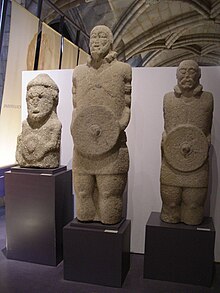Lusitan warrior statue
The Lusitanian-Gallic warrior statues are evidence of the pre-Roman era on the Iberian Peninsula . The life-size stone figures were found in various places in northern Portugal and in Spanish Galicia . According to Thomas G. Schattner, they represent protective deities, understood as warlike, in the clothing and equipment handed down for the Lusitans .
The dating of the figures entered into literature as "Gallaec warriors" or Lusitan warrior statues is controversial. The cuboid stele from São João de Ver , in which only the head is fully plastic, is regarded as a forerunner .
For the beginning of the erection of the figures there is a period from the 5th or 4th, but at the latest from the 3rd century BC. The torques (neck rings) depicted on the statues correspond to those found in the area. Their daggers are equivalent to the Iron Age weapons on the Iberian Peninsula. So there are indigenous ideas that have no Roman model. Latin inscriptions show that they were still standing or in use after the Roman conquest, but make dating more difficult. Original steles are likely to embody older phases of endemic sculpture.
The Lusitans, a Celtic Indo-European tribe, lived in an area that today corresponds to northern Portugal and western Spain. In the hilltop settlements of the Castro culture , around 30 statues were found that are interpreted as warriors or gods. They are very similar to Celtic sculpture in Central Europe . The Sanfins find provides a valuable but rare reference to the function of the statues as protective deities . The position on the outer wall is reminiscent of the Glauberg finds .
The statues are now in the Museu Nacional de Arqueologia in Lisbon and in local museums in Guimarães , Lisbon, Sanfins and Viana do Castelo . In the Museu Municipal in Viana do Castelo, there is the warrior statue of São Paio de Meixedo, (also known as 'Estátua de Viana' or 'do Páteo da Morte'), one of the three pieces that Emil Hübner presented in 1861.
literature
- Michael Blech : The Lusitan-Gallaec warrior statues in the light of the Iron Age Hispanic sculpture . In: German Archaeological Institute, Madrid Department (Ed.): Madrider Mitteilungen . Volume 44, pp. 162ff. Mainz, Zabern 2003. ISBN 3-8053-3258-0
- Martin Höck: The Lusitanischen warrior statues in northern Portugal : In: Hessische Kultur GmbH (Hrsg.): The riddle of the Celts from Glauberg . P. 229ff. Theiss, Stuttgart 2002. ISBN 3-8062-1592-8
- Michael Koch: The Lusitan-Gallaec warrior statues in their literary-epigraphic context . In: German Archaeological Institute, Madrid Department (Ed.): Madrider Mitteilungen . Volume 44, p. 67ff. Mainz, Zabern 2003. ISBN 3-8053-3258-0
- Thomas G. Schattner : The Lusitanian-Galläkischen warrior statues . In: German Archaeological Institute, Madrid Department (Ed.): Madrider Mitteilungen . Volume 44, pp. 1ff. Mainz, Zabern 2003. ISBN 3-8053-3258-0
- Thomas G. Schattner: Stylistic and formal observations on the warrior statues . In: German Archaeological Institute, Madrid Department (Ed.): Madrider Mitteilungen . Volume 44, p. 127ff. Mainz, Zabern 2003. ISBN 3-8053-3258-0
Web links
supporting documents
- ↑ The expression chosen by Emil Huebner in 1861 could not prevail. He described the statues of Ajuda, Cabeceiras de Basto and Paio de Meixedo or Viano do Castelo. Emil Hübner: Statues of Gaulish warriors in Portugal and Galicia . In: Imperial German Archaeological Institute: Archaeological Newspaper . No. 154, 1861, pp. 186ff. Reimer, Berlin 1861.
- ↑ Stone Warriors at the "End of the World" In: Archeology in Germany 2/2002 p. 34

